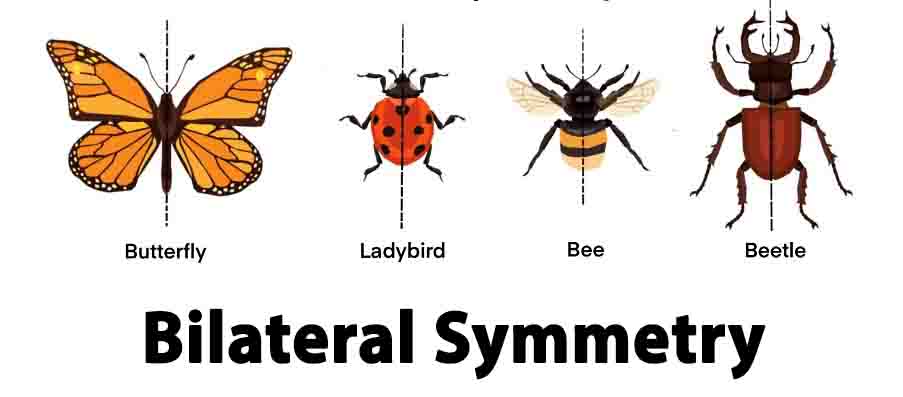Bilateral Symmetry Definition
Bilateral symmetry refers to creatures with body forms that are mirror reflections along a midline called the sagittal plane. The internal organs, however, are not necessarily distributed symmetrically.
The great majority of animals possess bilateral symmetry; sometimes known as plane symmetry, this is a characteristic that applies to 99% of all creatures, in the majority of phyla: Chordata, Annelida, Arthropoda, Platyzoa, Nematoda, and most Mollusca.
On the other side, the Cnidaria have radial symmetry while the Porifera exhibit no symmetry.
The Echinodermata are remarkable, in that they demonstrate bilateral symmetry in their larval stage, and a specific kind of fivefold radial symmetry, pentamerism in their adult life stage.
Bilaterally symmetrical creatures have a dorsal side (top), a ventral side (bottom) and distinct left and right sides. They also have an anterior side (head), and a posterior side (tail), and display cephalization. Cephalization is the clustering of sensory organs at the anterior; a body plan that originated because animals employ forward mobility, and hence this end is the first to face the external stimuli to which an organism must react.
The bilateral body arrangement may also be useful since it enables organisms to be more streamline. This would have been particularly crucial for ancestral species, which migrated through the oceans.
To test if an animal possesses bilateral symmetry, it is feasible to draw an imagined (or real!) line along the middle from its tip to the end; a bilaterally symmetrical animal would have two sides which are virtually identical, although a mirror image.
Examples of Bilateral Symmetry
Butterflies
Butterflies are a great example of near perfect bilateral symmetry. Not only do they have a body form that can be divided into symmetrical halves, but also the patterns on each wing of a butterfly are virtually similar to each other.
Humans
The bilateral symmetry in humans has been intensively investigated, and numerous benefits of the body type have been found. It may enable us to help the brain understand when various portion of the body are in different postures, making visual perception simpler and better coordination of movement.
Symmetry is also beneficial in terms of balance, and is important for forward-propelling movement in a specific direction as well as making the process of movement easier; for example, if a human had one leg longer than the other, they would be unable to walk or run effectively in the face of danger, so this is a trait which has stuck as being advantageous through evolution.
Loss of symmetry may be beneficial for recognising some health issues. Moreover, people have been proven to find faces, which are bilaterally symmetrical, more beautiful, as this is a sign of health and genetic fitness. Yet, faces are never fully symmetrical, and when inspected in close detail, exhibit substantial dissimilarity between left and right.
Bivalve Mollusks
Bivalve mollusks are a family of marine or freshwater creatures that have shells consisting of two hinged, bilaterally symmetrical halves; however, some species have subsequently lost their bilateral symmetry, for example oysters and gastropods such as snails.
In this group of creatures, the sagittal plane sits along the hinge, which allows the organism to securely seal its shell and protect the fragile interior body.
The picture displays the shell and interior body of a bivalve mussel. The symmetry of the two parts of the shell may be noticed in the bottom picture.
Related Biological Words
- Radial Symmetry – Refers to an organism, which has numerous planes that it might be sliced across, to generate essentially similar parts.
- Spherical Symmetry – Refers to creatures, which may be sliced directly through the centre in any direction without discernible difference between parts.
- Body Plan – The set of physical traits, which can identify an organism as belonging to a certain taxonomic group, such as a phylum.

